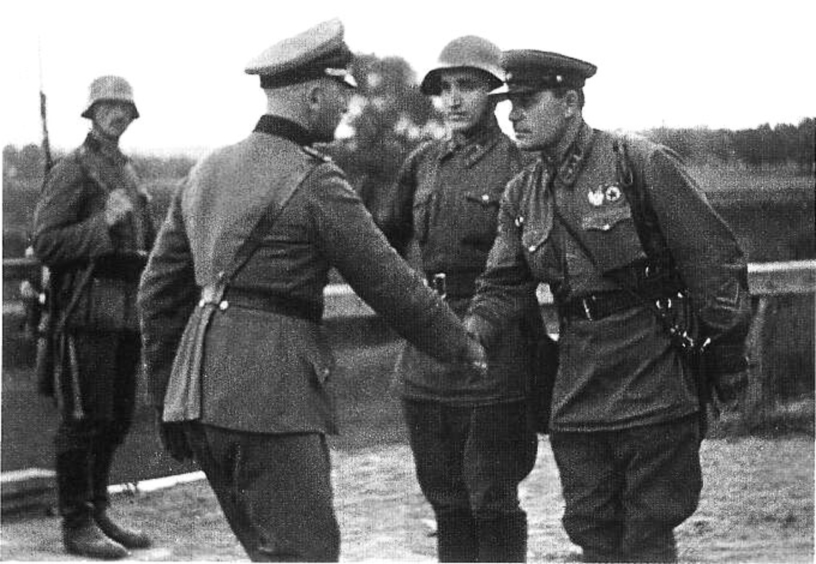On 17 September 1939, about 1 million troops of the Belarusian and Ukrainian Fronts of the Red Army crossed the eastern borders of Poland, thus violating the non-aggression pact of 1939. The Soviet invasion of Poland began.
On 25 July 1932, Poland and the USSR concluded a non-aggression pact in Moscow, which was meant to last until 1945. Since then, Polish foreign strategy was to lead a policy of balance, therefore not to make alliances with any of the two big powers: neither Germany, nor the USSR. The Polish foreign minister, Józef Beck, did not believe that Joseph Stalin would get politically closer to Adolf Hitler. One of his closest associates said that Beck believed that the dispute between Germany and the Soviet Union would last forever. In that situation, the Hitler-Stalin agreement of 1939 was almost completely unexpected, with the Soviet aggression of 17 September 1939 taking the Polish authorities, military and members of society by surprise. This was of such a scale that many people and soldiers were under the illusion that the Red Army was coming to their aid.
Soviet propaganda played a significant role in creating such an illusion, and it was even the more effective because the Soviet aggression occurred during a period of already significant fatigue and despair resulting from the German offensive.
The invaders continued to repeat that they came to help, and cries "Beat the Germans" were heard everywhere. The propaganda fulfilled its purpose to such an extent that in some places the Soviets were greeted with flowers and cries of joy. During the same period, Molotov summoned the Polish ambassador in Moscow and told him that "as the Republic of Poland had ceased to exist" measures had been taken to protect the residents of western Belarus and Ukraine.
In this situation, the general staff decided not to fight and instead to negotiate with the Soviets in order to reach Hungary and Romania. However, some units such as the troops of the Border Protection Corps, continued to fight. The directive was intended to minimise the number of soldiers being taken as prisoners and thus to create the possibility of remobilizing them outside the country.
Unfortunately, these attempts were largely unsuccessful. General Władyslaw Anders, commanding the Nowogrodzka Cavalry Brigade as they fought Soviet troops near the village of Władypol, on 27 September began a march towards the Hungarian border. A group of Border Protection Corp troops from the Polesie area, commanded by General Wilhelm Orlik-Rückemann, fought dozens of skirmishes and two major battles. At Szack it crushed the 52nd Rifle Division of the Red Army, and then disbanded following the battle of Wytyczno on 1 October.
Following the Soviet aggression, according to various sources between 200,000 and 250,000 Polish soldiers were taken prisoner; however, the number that had been killed is unknown. The Red Army suffered about 10 thousand soldiers killed, wounded or missing. This was the beginning of one of the darkest scenarios in Polish history. In September 1939, Polish prisoners began to be murdered in an action that intensified later and culminated in that most terrible of crimes in Katyn forest. The extent of the war crimes committed by the Soviets on Polish officers is estimated at over 8,000 people. There were also mass deportations of Poles, and in the years 1940-1941 about one million people were deported to Russia as part of the genocidal deportations of the Polish population.
In Brest on 22 September, Kombrig Semyon Kriwoszein and the German General Heinz Guderian watched a joint parade of German and Soviet armoured units. On 28 September, following the capture of Warsaw, Hitler and Stalin believed the campaign in Poland to be over. Both countries reached a common border, although this had to be revised due to the fact that Germany took more Polish territories than defined in the secret agreement. For this purpose, a special treaty on borders and friendship was signed, known as the second Molotov-Ribbentrop Pact, in which the Soviet Union agreed to give Germany the eastern part of Mazovia and the Lublin province in exchange for Germany agreeing that Lithuania would be in the Soviet sphere of influence. Thus the partition of Poland was sealed as a division of spheres of influence in the Baltic countries.
By Andrzej Włusek
Bibliography:
Jerzy Łojek: Agresja 17 września 1939 [Aggression of 17 September 1939]. Warsaw 1990
Karol Liszewski: Wojna Polsko-Sowiecka 1939 [Polish-Soviet War 1939]. London 1988
Norman Davies: God's Playground. A history of Poland. Kraków 1993
This article was prepared in cooperation with Historykon.pl.
